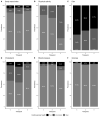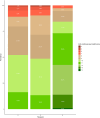Associations of Cardiovascular Health Metrics in Childhood and Adolescence With Arterial Health Indicators in Adolescence: The PANIC Study
- PMID: 39508145
- PMCID: PMC11681410
- DOI: 10.1161/JAHA.124.035790
Associations of Cardiovascular Health Metrics in Childhood and Adolescence With Arterial Health Indicators in Adolescence: The PANIC Study
Abstract
Background: Our aim was to assess the relationships of cardiovascular health metrics, cardiorespiratory fitness, lean mass, and fat percentage with arterial structure and function from childhood to adolescence.
Methods and results: Five hundred four children aged 6 to 9 years were examined in the PANIC (Physical Activity and Nutrition in Children) study at baseline, 2 and 8 years later. The associations of adjusted American Heart Association cardiovascular health metrics (smoking status, body mass index-SD score, moderate-to-vigorous physical activity, diet quality, plasma total cholesterol, systolic blood pressure, plasma glucose categorized into poor, intermediate, and ideal), the American Heart Association cardiovascular health score, cardiorespiratory fitness measured by maximal oxygen uptake in a bicycle exercise test, lean mass and fat percentage with carotid intima-media thickness (cIMT) and pulse wave velocity (PWV) were analyzed cross-sectionally and longitudinally in 277 participants at age 15 to 17 years. Higher American Heart Association cardiovascular health score at baseline was associated with lower PWV at 8-year follow-up (ß, -0.19 [95% CI, -0.32 to -0.05]). Higher body mass index-SD score and systolic blood pressure were associated with higher cIMT (ß, 0.18 [95% CI, 0.05-0.31]); and (ß, 0.13 [95% CI, 0.00-0.25]; respectively) and PWV (ß, 0.20 [95% CI, 0.07-0.34]) and (ß, 0.13 [95% CI, 0.00-0.26]; respectively) at 8-year follow-up. Higher moderate-to-vigorous physical activity was associated with higher cIMT (ß, 0.25 [95% CI, 0.07-0.43]); yet lower PWV (ß, -0.25 [95% CI, -0.44 to -0.06]) at 8-year follow-up. Better cardiorespiratory fitness (ß, 0.29 [95% CI, 0.08-0.51]) and higher lean mass (ß, 0.51 [95% CI, 0.03-0.98]) were associated with higher cIMT after accounting for American Heart Association cardiovascular health score at 8-year follow-up.
Conclusions: While our results suggest that higher cardiometabolic risk factors in childhood may exert unfavorable effects on arterial health during adolescence, we demonstrated the complexity of relationships between cardiovascular health metrics and arterial health indicators in childhood and adolescence. We found different associations of cardiovascular health metrics with cIMT and PWV in childhood and adolescence, calling for caution when interpreting the results of various cardiovascular risk factors with measures of arterial health, particularly in youth.
Registration: URL: https://www.clinicaltrials.gov; Unique identifier: NCT01803776.
Keywords: arterial function; arterial structure; cardiovascular risk; pediatrics.
Figures



References
-
- Lloyd‐Jones DM, Hong Y, Labarthe D, Mozaffarian D, Appel LJ, Van Horn L, Greenlund K, Daniels S, Nichol G, Tomaselli GF, et al. Defining and setting National Goals for cardiovascular health promotion and disease reduction: the American Heart Association's strategic impact goal through 2020 and beyond. Circulation. 2010;121:586–613. - PubMed
-
- Steinberger J, Daniels SR, Hagberg N, Isasi CR, Kelly AS, Lloyd‐Jones D, Pate RR, Pratt C, Shay CM, Towbin JA, et al. Cardiovascular health promotion in children: challenges and opportunities for 2020 and beyond: a scientific statement from the American Heart Association. Circulation. 2016;134:e236–e255. - PMC - PubMed
-
- Raitakari OT, Juonala M, Kähönen M, Taittonen L, Laitinen T, Mäki‐Torkko N, Järvisalo MJ, Uhari M, Jokinen E, Rönnemaa T, et al. Cardiovascular risk factors in childhood and carotid artery intima‐media thickness in adulthood: the cardiovascular risk in young Finns study. JAMA. 2003;290:2277–2283. - PubMed
-
- Li S, Chen W, Srinivasan SR, Bond MG, Tang R, Urbina EM, Berenson GS. Childhood cardiovascular risk factors and carotid vascular changes in adulthood: the Bogalusa heart study. JAMA. 2003;290:2271–2276. - PubMed
Publication types
MeSH terms
Substances
Associated data
LinkOut - more resources
Full Text Sources
Medical

